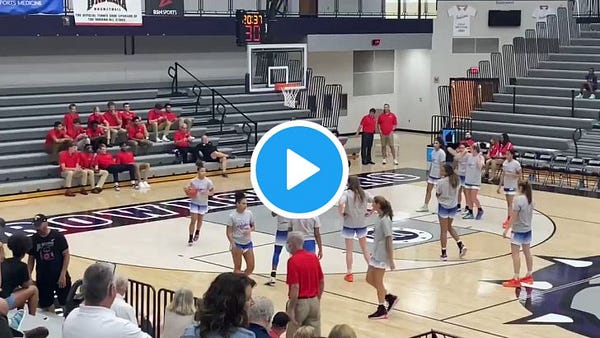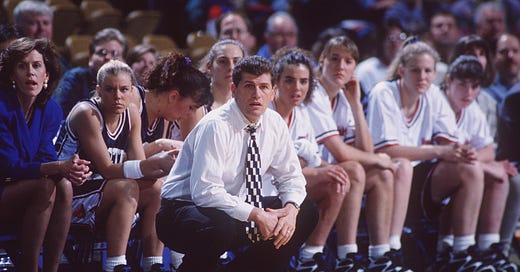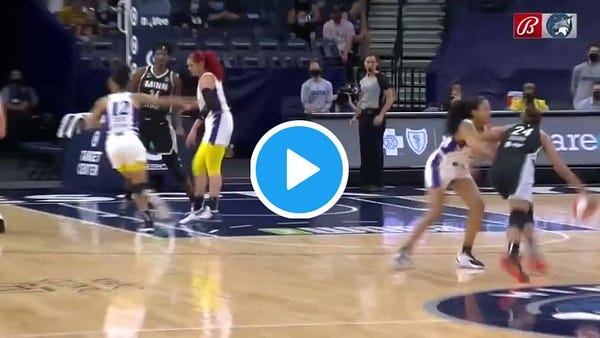Life at UConn before Geno Auriemma's arrival
For most, Geno Auriemma is UConn women’s basketball. But the Huskies’ program existed for 11 years with three different coaches before his arrival.
Welcome to the UConn WBB Weekly, a recap of everything that happened in the world of UConn women’s basketball over the past week from the team that runs The UConn Blog and Storrs Central.
Sign up to get the Weekly in your inbox every Thursday or subscribe to get our premium newsletter which includes film breakdowns, UConn in the WNBA updates, recruiting coverage and more!
Headlines
From the UConn WBB Weekly:
“Fudd is a walking bucket. She can do anything she wants on offense and doesn’t have any glaring weaknesses in her game, unlike practically every other high school player in the nation. Most of all, Fudd is an elite 3-point shooter.”
From The UConn Blog:
Aaliyah Edwards makes Canadian AmeriCup roster
In three games, Edwards has averaged 6.3 points and 5.0 rebounds in 17.5 minutes per game in the group stage of the AmeriCup.
Elsewhere:
Life before Geno
Before UConn women’s basketball was one of the top programs across all college sports with a massive following and legendary head coach, it was a mostly forgettable, chronically underfunded team at a regional state school.
In 1972, Title IX was passed and by 1974, UConn upgraded its women’s basketball team from club status into a varsity program.
The “upgrade” was more a formality than anything. The school hired Sandra Hamm as the first head coach, though she took over on a part-time, interim basis while also teaching physical education at a middle school in Manchester, according to the New York Times. The team didn’t have any scholarships to hand out and they had to share their locker room with other women’s teams.
UConn practiced at Guyer Gym, which featured a court that wasn’t full-sized and a roof that frequently leaked. It was common to see puddles on the floor after it rained.
Still two decades away from the 1995 season when fan interest and media coverage would explode, attendance at games often came in under three figures and any crowd in the hundreds was viewed as a massive success. What little media coverage they got was steeped in casual misogynism. From the New York Times:
“The women’s team, which had previously played as a club, was still an oddity on campus. The student newspaper, The Connecticut Daily Campus, published a preview of the team’s first season on Nov. 5, 1974 under the headline ‘They run and Swear, but They DO Play Hoop.’ The writer sounded like an anthropologist happening upon a new tribe.”
The Huskies started out 2-0 with wins over Eastern Connecticut and Keene State before dropping their final eight games to the likes of Springfield, Worcester State, Bridgewater State, and Bridgeport. They ended their inaugural season with a 2-8 record and Hamm recommended the school actually invest in the program with a full-time head coach.
Instead, UConn hired Wanda Flora, who was required to teach a PE class and help with the field hockey team in addition to her duties as the women’s basketball head coach. Over the next three seasons, the Huskies would go 7-12 each year and didn’t play a single opponent outside New England or New York City.
Many of the players played multiple sports, including Karen Mullins, who was also a member of the softball team (and went on to become UConn’s softball coach from 1984-2014). A freshman in 1975-76, she owns the distinction of being the first women’s basketball player to receive a scholarship at UConn — which was actually just leftover from the football team.
In 1977, the Huskies landed their first big recruit: Chris Gedney, an All-Metropolitan player from Maryland, who received the first women’s basketball scholarship in school history. She starred for the team, leading UConn in points, rebounds, and field goal percentage as a junior and senior (records don’t go back prior to that). Gedney became the first UConn player to reach 1,000 points and ranks eighth in program history with a 16.0 career scoring average.
But while Gedney excelled individually, she wasn’t happy with her team’s results. In her first three seasons, the Huskies never won more than nine games and were at least five games below .500 each year.
In particular, Gedney wasn’t happy with some of Flora’s coaching decisions and believed the school’s administration didn’t care about the team’s success — or lack thereof. As a result, she called a team meeting.
“We were given scholarships, practice uniforms, sneakers, and the like, but yet, we still felt like second class athletes because of the coaching situation, our practice times, weight training times, etc. We always had to defer to the men’s teams and their preferences,” Gedney told Storrs Central in 2002. “And here we were with a coach that had never posted a winning season in her fifth year and made extremely questionable coaching moves, yet the administration continued to support her without question. It seemed to me that we were just being paid lip service.”
“We wanted to get in touch with the administration. [The players] were taking our team seriously and we wanted to know when the administration would take us seriously as well,” Gedney said. “Our goal was to call the administration’s attention to the coaching situation, but that was not meant to be.”
Once Flora caught wind of the coup, she kicked Gedney off the team. Gedney protested to the AIAW — the governing body of women’s sports at the time — who found no cause for Gedney’s dismissal and determined that UConn violated the organization’s rules by revoking the scholarship. Because of this, the AIAW banned all the Huskies’ women’s teams from the postseason until they found a solution, according to Storrs Central.
Flora eventually resigned with a 28-66 record over five seasons. In 2010, she told the Hartford Courant that she was “burned out”, not fired. Gedney insisted in the same story that the feud was nothing personal, instead describing it as a “generational” difference.
UConn hired Jean Balthaser as her replacement. The Huskies went 16-14 in their first year under Balthaser — the only winning season in program history before Auriemma’s arrival — and made the Eastern Regionals of the EAIAW Tournament before falling to St. John’s, 93-56.
The next season, the NCAA created a women’s basketball postseason tournament for the first time and in 1983, the Big East began to sponsor the sport.
Despite the strong first season under Balthaser, UConn won nine games each of the next four seasons and went 4-28 in its first three years in the Big East. The school let Balthaser go and began looking for a replacement, someone who could finally make the program respectable. From the New York Times:
“Pat Meiser-McKnett, who was hired as the senior women’s administrator in 1983 and oversaw women’s athletics, said the school’s administrators decided to make a change (at head coach). They wanted the basketball team to be the vanguard women’s sports program at UConn, the kind of program that could move the whole movement for equality forward, said Ms. Meiser-McKnett... Basketball, she said, could generate revenue and fill seats more quickly than sports like tennis, golf or swimming.”
When the school began its search, Meiser-McKnett wanted UConn to hire a woman to lead the program, especially since the three previous coaches were all women. But when she met with the players, they stressed that they just wanted the best coach for the job, according to The Same River Twice by John Walters.
Eventually, UConn tapped an up-and-coming assistant coach at Virginia by the name of Geno Auriemma. You know the rest.
According to the Courant, both Flora and Gedney remain steadfast UConn fans, even if the program they were both a part of barely resembles the current iteration. The Huskies return the favor, too. Although UConn’s most prolific players have all played under Auriemma, he’s welcomed those that preceded him back with open arms.
“He makes us ‘old timers’ feel like we were an integral part of the team’s history and tradition and that what we did, way back when no one seemed to care, were the building blocks of the program that exists today,” Gedney told Storrs Central.
Best of social media
UConn’s 2022 commit Ayanna Patterson has HOPS:


Tina Charles will be releasing a movie at the Tribeca Film Festival on June 17.


The current UConn players watched some former UConn players play at Mohegan Sun:
Best not to push Napheesa Collier:
Stef Dolson is excited for gameday (warning: strong language used):
?utm_medium=copy_link
Gabby Williams once invited a... unique guest while at UConn:

Quotables
A couple of great lines from Gedney in the Storrs Central piece from 2002 referenced earlier:
“But I’m very glad for the WNBA because if I couldn’t see Sue Bird play again, I would just die.”
“I hate Tennessee. I hate Pat Summitt, not as a person but as the Tennessee coach. I hate the color orange...In fact, if I’m going to eat a piece of fruit, I’m going to have an apple, never an orange.”










Thanks for the article...but for the New Jacks, one must remember that women's sports back in the late '60's, the early '70's was not seen as serious. I remember in the early '70's even the men didn't have great training facilities. The Men's Basketball team practiced in the Field House with these huge curtains around the court (for privacy). Meanwhile the track around the court was used by students & facility to jog, and right off the court many used the Universal Weight machine.
I remember some of the early women's games in the Field House. The teams played while the students & facility used the track around the court and the weight machine. I remember occasionally stopping my workouts to watch a few minutes of their games. It wasn't until UCONN played Central CT. State College (at the time) that I seriously took notice. Central had a Hispanic guard who dribbled and handled the ball as well as any male guard that I had seen. No other woman dribbling the ball dribble the way she did. She was so impressive that I called my friends over and we all sat in the bleachers and watched the entire game. Afterwards I told that that "That is the future of Women's Basketball"....and it has been.
Another issue with that era was the limited budgets, which is why the women's team played a lot of local schools. The Male programs were well established and required the bulk of the revenue. During those years, Freshmen were NOT ALLOWED to play varsity. So, schools had to maintain a Junior Varsity Squad and a Varsity Squad. Schools used their JV Squads to develop their freshmen and that entailed playing other schools, traveling, practicing, etc...
It wasn't right that women were considered not as important as the men, and I'm grateful that things have changed. Many things have changed....I'm old enough to remember when Great football players like Jim Brown, John Mackey and Basketball players like Wilt Chamberlain, Bill Russell, Oscar Robertson, KC Jones, and many others were not allowed to stay in White Hotels in the south with their teammates, and they were relegated to "colored motels" or they had to stay with a Black opposing player's family because of racial segregation. So, much has changed....and yet there is still work to do.
Great stuff as always, thanks Dan